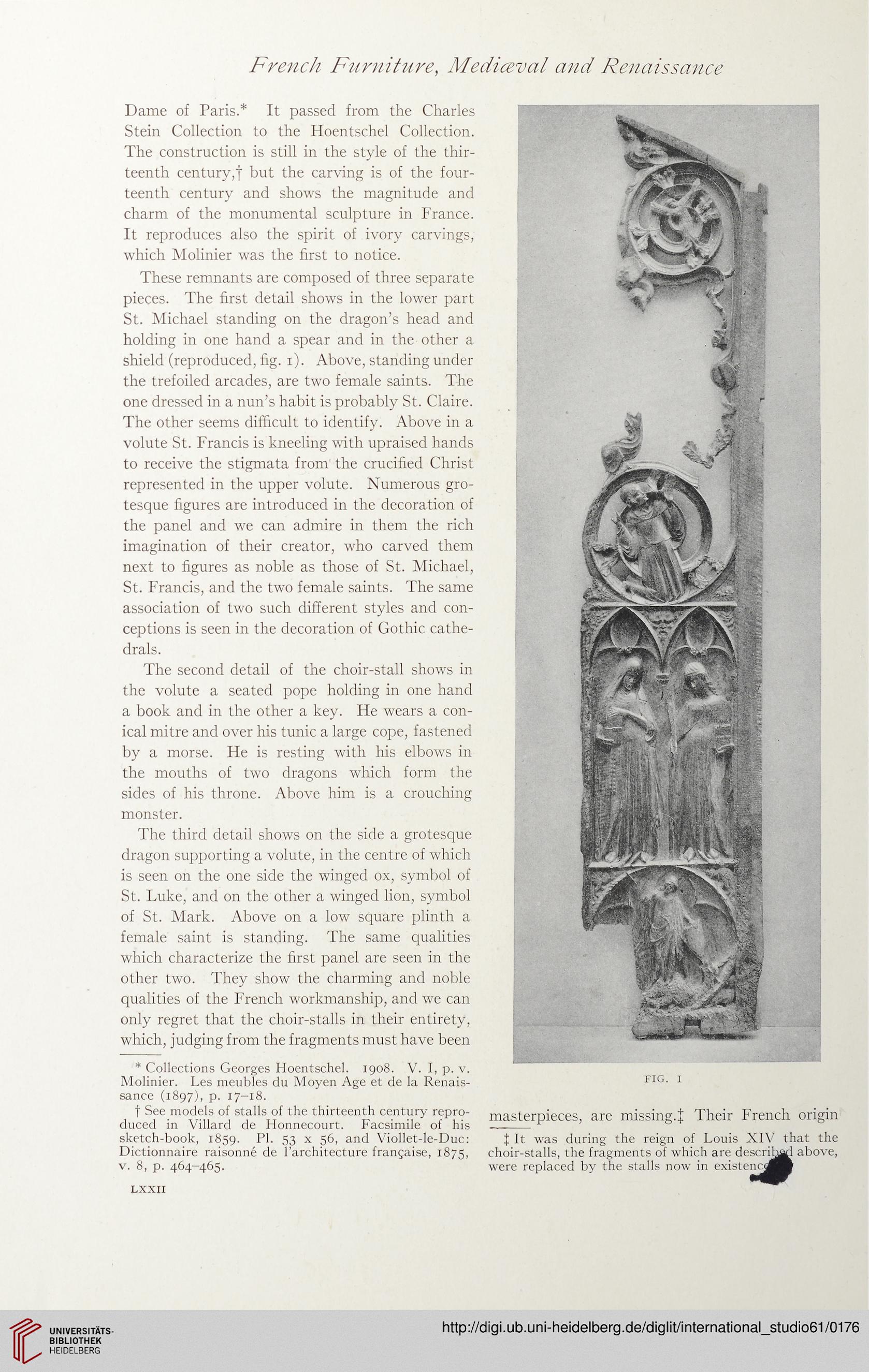French Furniture, Mediceval and Renaissance
Dame of Paris.* It passed from the Charles
Stein Collection to the Hoentschel Collection.
The construction is still in the style of the thir-
teenth century,f but the carving is of the four-
teenth century and shows the magnitude and
charm of the monumental sculpture in France.
It reproduces also the spirit of ivory carvings,
which Molinier was the first to notice.
These remnants are composed of three separate
pieces. The first detail shows in the lower part
St. Michael standing on the dragon’s head and
holding in one hand a spear and in the other a
shield (reproduced, fig. i). Above, standing under
the trefoiled arcades, are two female saints. The
one dressed in a nun’s habit is probably St. Claire.
The other seems difficult to identify. Above in a
volute St. Francis is kneeling with upraised hands
to receive the stigmata from the crucified Christ
represented in the upper volute. Numerous gro-
tesque figures are introduced in the decoration of
the panel and we can admire in them the rich
imagination of their creator, who carved them
next to figures as noble as those of St. Michael,
St. Francis, and the two female saints. The same
association of two such different styles and con-
ceptions is seen in the decoration of Gothic cathe-
drals.
The second detail of the choir-stall shows in
the volute a seated pope holding in one hand
a book and in the other a key. He wears a con-
ical mitre and over his tunic a large cope, fastened
by a morse. He is resting with his elbows in
the mouths of two dragons which form the
sides of his throne. Above him is a crouching
monster.
The third detail shows on the side a grotesque
dragon supporting a volute, in the centre of which
is seen on the one side the winged ox, symbol of
St. Luke, and on the other a winged lion, symbol
of St. Mark. Above on a low square plinth a
female saint is standing. The same qualities
which characterize the first panel are seen in the
other two. They show the charming and noble
qualities of the French workmanship, and we can
only regret that the choir-stalls in their entirety,
which, judging from the fragments must have been
* Collections Georges Hoentschel. 1908. V. I, p. v.
Molinier. Les meubles du Moyen Age et de la Renais-
sance (1897), p. 17-18.
t See models of stalls of the thirteenth century repro-
duced in Villard de Honnecourt. Facsimile of his
sketch-book, 1859. PL 53 x 56, and Viollet-le-Duc:
Dictionnaire raisonne de 1’architecture frangaise, 1875,
v. 8, p. 464-465.
LXXII
FIG. I
masterpieces, are missing.J Their French origin
} It was during the reign of Louis XIV that the
choir-stalls, the fragments of which are descril^l above,
were replaced by the stalls now in existencd^w
Dame of Paris.* It passed from the Charles
Stein Collection to the Hoentschel Collection.
The construction is still in the style of the thir-
teenth century,f but the carving is of the four-
teenth century and shows the magnitude and
charm of the monumental sculpture in France.
It reproduces also the spirit of ivory carvings,
which Molinier was the first to notice.
These remnants are composed of three separate
pieces. The first detail shows in the lower part
St. Michael standing on the dragon’s head and
holding in one hand a spear and in the other a
shield (reproduced, fig. i). Above, standing under
the trefoiled arcades, are two female saints. The
one dressed in a nun’s habit is probably St. Claire.
The other seems difficult to identify. Above in a
volute St. Francis is kneeling with upraised hands
to receive the stigmata from the crucified Christ
represented in the upper volute. Numerous gro-
tesque figures are introduced in the decoration of
the panel and we can admire in them the rich
imagination of their creator, who carved them
next to figures as noble as those of St. Michael,
St. Francis, and the two female saints. The same
association of two such different styles and con-
ceptions is seen in the decoration of Gothic cathe-
drals.
The second detail of the choir-stall shows in
the volute a seated pope holding in one hand
a book and in the other a key. He wears a con-
ical mitre and over his tunic a large cope, fastened
by a morse. He is resting with his elbows in
the mouths of two dragons which form the
sides of his throne. Above him is a crouching
monster.
The third detail shows on the side a grotesque
dragon supporting a volute, in the centre of which
is seen on the one side the winged ox, symbol of
St. Luke, and on the other a winged lion, symbol
of St. Mark. Above on a low square plinth a
female saint is standing. The same qualities
which characterize the first panel are seen in the
other two. They show the charming and noble
qualities of the French workmanship, and we can
only regret that the choir-stalls in their entirety,
which, judging from the fragments must have been
* Collections Georges Hoentschel. 1908. V. I, p. v.
Molinier. Les meubles du Moyen Age et de la Renais-
sance (1897), p. 17-18.
t See models of stalls of the thirteenth century repro-
duced in Villard de Honnecourt. Facsimile of his
sketch-book, 1859. PL 53 x 56, and Viollet-le-Duc:
Dictionnaire raisonne de 1’architecture frangaise, 1875,
v. 8, p. 464-465.
LXXII
FIG. I
masterpieces, are missing.J Their French origin
} It was during the reign of Louis XIV that the
choir-stalls, the fragments of which are descril^l above,
were replaced by the stalls now in existencd^w




